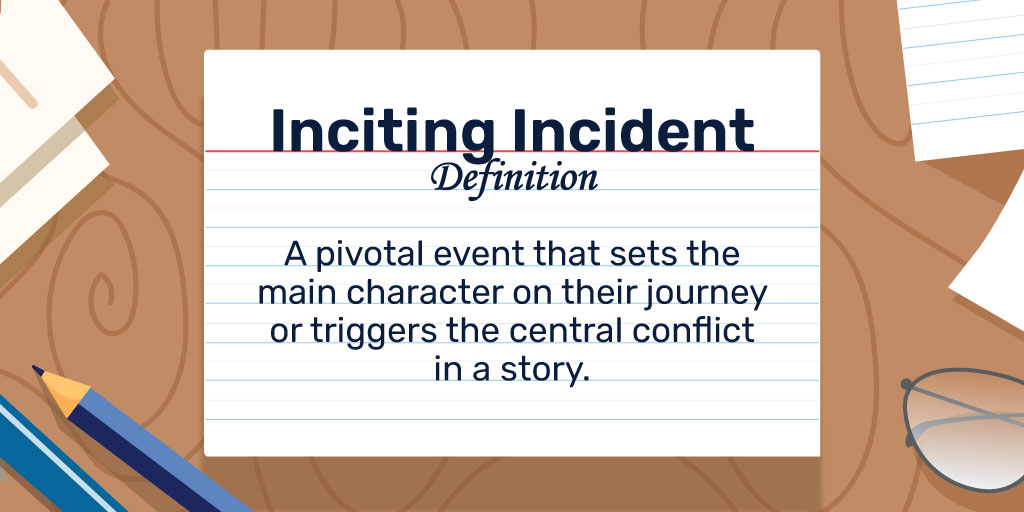Every gripping tale begins with a spark – an event that propels the narrative into a whirlwind of action, emotion, and transformation. This spark, known in the literary world as the inciting incident, is the heartbeat of every story. It’s the moment that turns the ordinary into the extraordinary, drawing readers into a journey filled with challenges, discoveries, and changes. The inciting incident is more than just a plot device; it’s a pivotal catalyst that sets the entire story in motion, holding the power to deeply engage the reader and shape the path of the narrative.
What is an Inciting Incident?

In the realm of storytelling, the inciting incident is the pivotal event that triggers the primary plot of a story. It’s a moment, occurring usually in the initial chapters or scenes, that disrupts the life or world of the protagonist, setting them on a course filled with challenges, adventures, and growth. This incident is the narrative’s game-changer – it shifts the status quo and compels the protagonist to act or respond.
The inciting incident can take various forms, from a simple conversation to a dramatic event. It’s essential to differentiate it from just any plot event; it must be directly related to the central conflict of the story and intimately tied to the protagonist’s journey. It’s what makes the story a story. Without this crucial incident, the narrative would remain stagnant, leaving the characters untouched and the readers unengaged. It’s the bridge between the story’s setup and its ensuing action, ensuring that the narrative has direction, purpose, and a hook to capture the reader’s interest.
What is the Purpose of an Inciting Incident?

The primary purpose of the inciting incident is to introduce the central conflict of the story and set the protagonist on their journey. It acts as the catalyst that disrupts the normal world of the character, compelling them to face challenges and pursue their goals or desires. This incident is integral in connecting the reader to the narrative, as it provides a reason to care about the protagonist’s journey and the outcomes of their actions.
Beyond initiating the plot, the inciting incident serves several key functions. It establishes the stakes of the story, highlighting what the protagonist stands to gain or lose. It also reveals key aspects of the protagonist’s character, as their response to this incident offers insights into their personality, values, and motivations. In essence, the inciting incident is the narrative’s turning point, shifting it from exposition to action and from setup to conflict. It’s a storytelling tool that ensures the narrative remains dynamic and engaging, driving both character development and plot progression.
7 Types of Inciting Incidents

In the art of storytelling, various types of inciting incidents can set a narrative in motion. Each type serves a unique purpose, igniting the protagonist’s journey in its own distinctive way. Let’s explore seven compelling types:
- 1. Call to Adventure: Often the starting point in classic hero’s journeys, this type of inciting incident invites the protagonist into a new and unknown world. It’s a beckoning for adventure, offering a departure from the ordinary, and presenting an opportunity for growth and transformation.
- 2. Life-Altering Event: This Incident thrusts the protagonist into a new reality through a significant event, like a loss, a win, or a major change in life circumstances. It’s a pivotal moment that forever alters the character’s world, demanding adaptation and resilience.
- 3. Mystery or Puzzle: Here, the inciting incident presents an enigma or challenge that beckons the character to solve. It’s a lure of the unknown, a puzzle that must be pieced together, driving the narrative with curiosity and intrigue.
- 4. Threat or Danger: This form introduces immediate risk or peril, thrusting the leading character into a situation where they must confront danger or face significant challenges. It’s a catalyst that demands action and survival instincts, setting the stage for high stakes and suspense.
- 5. Revelation or Discovery: A sudden revelation or discovery can serve as an inciting incident, unveiling a hidden truth or a new perspective that changes everything for the protagonist. This type often leads to a reevaluation of beliefs and a significant shift in the character’s journey.
- 6. Moral Dilemma: This incident confronts the character with a challenging ethical choice, where the decision made will set the course of the story. It’s a moment of introspection and conflict, testing the character’s values and principles.
- 7. Forced Into Action: Sometimes, the protagonist is thrust into the narrative against their will. This inciting incident leaves no room for choice, compelling the character into action due to external forces or unavoidable circumstances, setting off a chain of events.
Placements of Inciting Incidents

The placement of an inciting incident is a strategic decision in storytelling, directly influencing the pace and engagement level of the narrative. Here are six common placements, each offering a unique way to kickstart the story’s momentum:
- Early Placement: Placing the inciting incident early on, often in the opening pages, immediately hooks the reader with action or a significant event. It’s a method that quickly immerses the audience in the story, setting the tone and pace right from the start.
- After Some Setup: This approach allows for some initial world-building and character introduction before the inciting incident occurs. It offers readers a chance to connect with the setting and characters, creating a more impactful reaction when the Incident disrupts this established normality.
- Gradual Lead-Up: Here, the story builds slowly towards the inciting incident, layering hints and subtle developments. This method fosters suspense and anticipation, gradually drawing the reader deeper into the unfolding narrative.
- Delayed Placement: Delaying the inciting incident can create a sense of mystery or deep character exploration. It’s a technique that often involves more complex storytelling, where the Incident’s impact is intensified by its delayed arrival.
- In Media Res: Starting the story ‘in the midst of things’ throws the reader directly into an action or situation, with the inciting incident already unfolding. This method demands immediate engagement, as the readers must swiftly orient themselves within the story.
- As a Flashback: When used as a flashback, the inciting incident is revealed after some of the story has already been told. This technique can provide context to the current events and add layers to the narrative, enhancing the depth and understanding of the plot and characters.
How Do You Identify the Inciting Incident?

Identifying the inciting incident in a story is key to understanding its structure and progression. This pivotal moment is not just any plot point, but a specific marker that sets the entire narrative in motion. Let’s delve into the nuances of recognizing this crucial event.
Look for a Change
This pivotal moment is often marked by a change, either in the protagonist’s life or their world. This change disrupts the status quo and challenges the protagonist, compelling them to act. It could be something as grand as a world-altering event or as subtle as a shift in a relationship. This transformation is crucial, as it moves the story from exposition to action, nudging the protagonist out of their comfort zone and into the narrative’s main conflict.
Timing
Timing is crucial in identifying the inciting incident. It usually occurs early in the story, often in the first few chapters or scenes. This early placement ensures that the reader’s interest is piqued and the narrative gains momentum. However, the exact timing can vary, sometimes appearing after some initial setup to provide context. Regardless, its occurrence sets the rest of the story in motion, defining the trajectory of the narrative.
Conflict Introduction
The introduction of a conflict is an essential aspect of an this critical event. This conflict, whether internal or external, challenges the protagonist and drives the story. It can manifest as a disagreement, a dilemma, or a threat that the protagonist must confront. This conflict is the catalyst for the story’s central plot, shaping the protagonist’s actions and decisions as the narrative unfolds.
Decision Point
An inciting incident often leads to a crucial decision point for the protagonist. This moment is where the character must make a significant choice, which will determine their path throughout the story. It’s a point of no return that pushes the protagonist to engage with the conflict and embark on their journey. The decision made here is a clear indicator of the inciting incident, as it directly influences the course of the story.
Irreversible Change
Finally, look for an irreversible change. The inciting incident should introduce a change that cannot be undone, compelling the protagonist to move forward. This change fundamentally alters the protagonist’s life or perspective, making it impossible to return to how things were before. It sets the stage for the ensuing narrative, ensuring that the story progresses towards its ultimate resolution.
4 Examples of Inciting Incidents

The inciting incident is the spark that ignites the story’s action. Its role is to disrupt the protagonist’s world, ushering in the central conflict. Let’s explore this through examples from four iconic novels.
“Harry Potter and the Philosopher’s Stone” by J.K. Rowling
J.K. Rowling’s “Harry Potter and the Philosopher’s Stone” pivots around a seemingly ordinary letter that upends Harry’s life. This letter from Hogwarts School of Witchcraft and Wizardry marks the beginning of an extraordinary journey. Far from ordinary, it reveals a hidden magical world to Harry, breaking the monotony of his previous life. The persistent arrival of the letters, thwarting his aunt and uncle’s efforts to keep him in the dark, symbolizes destiny’s call. This moment is pivotal, signifying Harry’s shift from obscurity to a path filled with magic, self-discovery, and destiny.
“Pride and Prejudice” by Jane Austen
In “Pride and Prejudice”, the narrative takes a turn with Mr. Bingley’s arrival. His presence in the Bennet’s neighborhood fuels Mrs. Bennet’s matrimonial ambitions and intertwines the lives of Elizabeth Bennet and Mr. Darcy. This event not only initiates the central story but also sets the stage for exploring themes of class, social etiquette, and, of course, the complexities of pride and prejudice. It is this arrival that marks a transformative period for the Bennet sisters, opening doors to romantic endeavors and societal challenges.
“The Hunger Games” by Suzanne Collins
Suzanne Collins’ “The Hunger Games” thrusts its protagonist, Katniss Everdeen, into the limelight with the reaping ceremony. Her voluntary act to replace her sister Prim as a tribute is more than self-sacrifice; it’s a defiance of a dystopian regime. This moment underscores the novel’s themes of survival, tyranny, and rebellion. Katniss’s decision is not just about saving her sister; it’s a catalyst that eventually leads to a larger uprising, challenging the Capitol’s oppressive rule.
“To Kill a Mockingbird” by Harper Lee
Harper Lee’s “To Kill a Mockingbird” features its inciting incident when Atticus Finch takes on the defense of Tom Robinson. This moment shatters the tranquility of Maycomb, Alabama, and thrusts the Finch family into a contentious racial controversy. Through Scout’s perspective, readers are exposed to the raw and complex layers of human nature, prejudice, and justice. This assignment not only challenges the characters but also serves as a critical commentary on societal issues of the era.
How to Write an Inciting Incident

Crafting an inciting incident is akin to setting the first domino in a chain reaction – it’s the pivotal moment that propels your story into motion. In the following sections, we’ll delve into the craft of creating an inciting incident that not only intrigues but also anchors the reader firmly in your story’s unfolding drama.
1. Establish the Status Quo
To effectively disrupt the world of your story, you first need to establish a clear status quo. This involves painting a vivid picture of the protagonist’s life and world before the inciting incident. Detail their daily routines, relationships, challenges, and desires. This context is crucial as it sets the baseline from which change will occur. By grounding the reader in the ‘normal’ world, the impact of the subsequent disruption becomes more pronounced. It’s not merely about depicting mundane details; it’s about creating a contrast. When the status quo is well-established, any deviation from it becomes more impactful, setting the stage for meaningful character development and a compelling narrative.
2. Create a Disruptive Event
The core of a compelling story often lies in a significant, life-altering event. This event must be significant enough to compel change, challenging the protagonist’s current situation or worldview. It could be an unexpected opportunity, a sudden tragedy, or a startling revelation. The key is to ensure that this event is not just a minor inconvenience but a turning point that makes the continuation of the status quo impossible. This disruption should be closely tied to the protagonist’s desires, fears, or conflicts, making it deeply personal and emotionally resonant. It’s the spark that ignites the story’s engine, driving the protagonist out of their comfort zone and into the narrative arc.
3. Link it to the Central Conflict
An effective inciting incident is intricately connected to the story’s central conflict. It should introduce or hint at the primary struggle the protagonist will face. This linkage ensures that the incident isn’t just a random occurrence but a pivotal moment that propels the narrative forward. By tying the inciting incident to the central conflict, you establish a clear direction for your story and give your protagonist a purpose or challenge to overcome. This connection is vital for maintaining narrative coherence and ensuring that every element of your story contributes to its overall trajectory.
4. Force a Decision or Change
This key moment should necessitate a significant decision or transformation in the protagonist. This decision or change is often fraught with risk, uncertainty, or moral complexity, pushing the protagonist out of their comfort zone. It should challenge their beliefs, desires, or abilities, setting them on a path of growth, discovery, or conflict resolution. This aspect of the inciting incident is crucial as it not only drives the plot forward but also serves as a catalyst for character development. The decision or change should be consequential, setting the tone for the protagonist’s journey and the choices they will face throughout the story.
5. Propel the Story Forward
A compelling narrative kickoff serves as a bridge from the exposition to the rising action, injecting the story with momentum and direction. It marks the end of the story’s exposition phase and the beginning of the rising action. This momentum is crucial for keeping the reader engaged and invested in the narrative. The incident should open up new possibilities, challenges, or adventures for the protagonist, moving them closer to their ultimate goal or confrontation. It’s a bridge from the known to the unknown, from stability to chaos, from comfort to challenge, driving the story into its next phase with energy and purpose.
6. Foreshadow Future Challenges
An effective narrative catalyst often foreshadows the challenges and themes that will permeate the story. It can hint at future conflicts, moral dilemmas, or personal struggles the protagonist will encounter. This foreshadowing enriches the narrative, adding layers of depth and complexity. It prepares readers for what’s to come, building anticipation and tension. However, this should be done subtly, without revealing too much too soon. The art of foreshadowing lies in planting seeds that will grow and make sense as the story unfolds, weaving a rich tapestry of narrative threads that will come together in a satisfying conclusion.
Frequently Asked Questions
In the journey of storytelling, numerous questions arise about the structure and elements of a narrative. Among these, questions related to the inciting incident are particularly common, reflecting its critical role in story development. Let’s explore some of these frequently asked questions.
What is Another Word for Inciting Incidents?
Another word for inciting incidents is “catalyst”. This term aptly describes an event that precipitates change, sparking the main action of a story. It signifies a moment that propels the protagonist into the narrative’s central conflict, setting the plot in motion.
Do All Stories Have an Inciting Incident?
Yes, virtually all stories have an inciting incident. It’s a fundamental element that launches the narrative. However, its nature and timing can vary greatly. In some stories, it’s a dramatic event, while in others, it’s a subtle shift that sets the plot unfolding.
When Should an Inciting Incident Occur?
The inciting incident typically occurs near the beginning of a story. It’s essential for capturing the audience’s interest early on. While its exact placement can vary, it usually happens within the first few chapters or scenes, setting the direction for the story.
Can a Story Have Two Inciting Incidents?
While a story traditionally has one primary inciting incident, it can have secondary events that also propel the plot forward. These secondary incidents often introduce new challenges or complications, adding depth and complexity to the narrative.
Can an Inciting Incident Be a Flashback?
Yes, an inciting incident can be presented through a flashback. This technique is used to provide background information that is crucial to the current story, allowing the audience to understand the events leading up to the main narrative.
What Comes After an Inciting Incident?
Following the inciting incident, the story progresses into rising action. This phase involves the development of the plot and characters, building tension and complications leading up to the climax. It’s where the consequences of the inciting incident become more apparent.
Is Inciting Incident the Same as Climax?
No, the inciting incident and the climax are distinct narrative elements. The inciting incident starts the story’s action, while the climax is the peak of the story’s tension and conflict, often leading to a resolution.
Is an Inciting Incident the Same as the First Plot Point?
The inciting incident and the first plot point, while closely related, are not the same. The inciting incident kicks off the story, while the first plot point is a key event at the end of the first act that firmly establishes the direction of the narrative.






